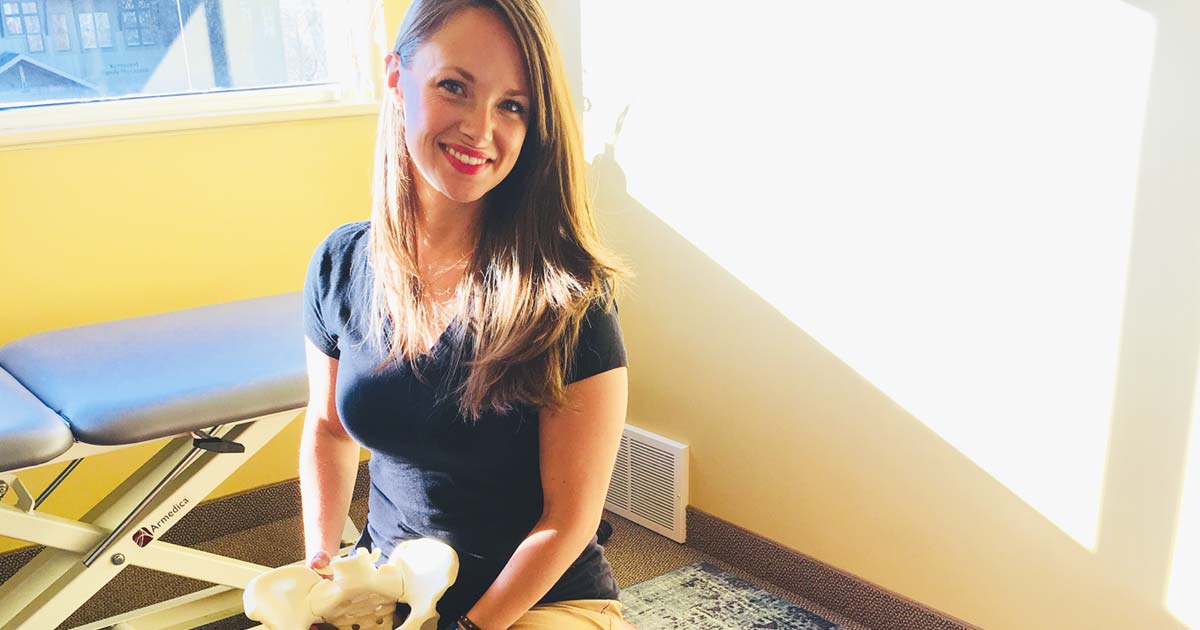Do you cross your legs when you sneeze?
Have you ever laughed so hard, tears ran down your legs?
Let’s talk about your pelvic floor.
What? A pelvic floor? What is that? Do I have one?
As a pelvic floor physical therapist, these are questions I experience regularly.
Why is one of the most important muscle groups in our bodies getting no attention?
There has been a recent push for overall wellness—including getting the right amount of daily exercise, eating clean and healthy, and avoiding toxic preservatives and chemicals—but we often forget our pelvic floor.
Yes, that thing deep in our pelvis, that woven basket of muscles present in both men and women. That entity that contributes to our overall health because it affects our bladder and bowel function, our posture, our ability to sit and stand.
Your pelvic floor muscles run from your pubic bone to your tailbone and lie like a sling or hammock at the bottom of your pelvis. These muscles help support the organs within the lower abdomen and pelvis (urinary, digestive and reproductive organs). They are responsible for stopping uninvited passage of urine, bowel and gas. They also provide pelvic organ support; low back, pelvic and hip stability; and play a major role in sexual function.
But before we continue, some staggering statistics.
Urinary Incontinence (UI)—or leaking of urine—is a stigmatized, underreported, underdiagnosed, undertreated condition that is erroneously thought to be a normal part of aging.
Stop right there!
We should never accept peeing our pants as a normal part of life.
Nearly a third of men and women between ages 30 and 70 have lost control of their bladder involuntarily at least once in their lives, and may continue to experience symptoms. Only 1 in 8 Americans suffering from bladder leaking have been diagnosed, leaving 87 percent with a treatable condition that has adverse effects on the performance of daily activities, social interaction and overall quality of life. (Have you ever had to tell your kids “no” to jumping on the trampoline with them because you’ll pee your pants? Have you ever skipped that exercise class because you don’t want to leak in public?)
Patients with continence disorders frequently report low back and pelvic pain, which is often referred to as myofascial pelvic pain. It is estimated that 1 in 7 women in the United States, although undiagnosed, suffer from pelvic pain—which accounts for 60,000 to 70,000 procedures annually. Myofascial pelvic pain also deleteriously impacts daily life and relationships, and may impede wellness checks such as gynecological exams.
In many cases, a painful pelvic floor, regardless of the cause, loses its ability to perform optimally, and therefore decreases the ability to maintain bowel, bladder and gas control. Recent reports reveal women spend an average of about $750 per woman, per year, for medication, pads, laundering clothes and more to manage UI. This does not take into account the procedures discussed above.
Note to my ladies:
- Losing urine involuntarily at any age beyond adolescence IS NOT NORMAL. It is not a sign of aging and you do not have to struggle with this!
- Pelvic pain, at any time, IS NOT NORMAL. You do not have to live your life in pain.
Treatment is available—without any adverse side effects you may experience with medications.
Pelvic floor physical therapy is a conservative way to treat pelvic floor dysfunction, which includes bladder and bowel dysfunction, abdominal bloating and/or pain, pelvic pain, sexual pain, low back or hip pain. If you are experiencing pain or difficulty controlling your bladder, please speak with your health care provider about seeking treatment!
What about Kegels?
“But I do my Kegels, why am I still leaking?”
Do any of us really know which muscles to squeeze down there?
Studies show many women report practicing Kegels to help strengthen their pelvic floor musculature; however, these studies also reveal a large portion of women performing Kegels incorrectly. Several studies also reveal better results once instructed by a pelvic floor specialist, versus reading instructions from a sheet of paper. If you are performing your Kegels incorrectly, you may be worsening your symptoms instead of helping! So, head on out to your local pelvic floor specialist and ask if you are doing them correctly. They will give you tips on how to optimize each contraction to get the most out of your efforts!
The correct action of a pelvic floor muscle contraction is a combination sensation of squeezing and lifting and should be felt from the very front near your pubic bone to the back, near your tailbone. The squeezing action facilitates closure of the urethral and anal openings to help maintain bowel and bladder control, while the lifting action helps to support the organs. Contraction of these muscles also facilitates sexual function, a response to arousal, which can result in orgasm.
Feel like your orgasms are less intense?
Perhaps your pelvic floor needs a bit of TLC!
Let’s give it a go!
- Scooch towards the edge of your seat; sit nice and tall with your feet planted on the ground.
- Draw your navel inward towards your spine, as though you are pulling your belly button away from the button or elastic of your pants. This should not be a “sucking in” movement, but a gentle hugging inward of the lower abdominals. Sit as tall as you can; this will help your deep core stabilizers activate.
- Now, squeeze your pelvic floor muscles as though you are stopping the flow of urine (or holding back gas in a crowded elevator). Then relax.
- If you struggle with urinary incontinence, focus on better closure around the urethra. Lean forward a little bit and contract again. You should feel the front of your pelvic muscles contract a little stronger. Relax.
- Repeat. As you breathe out, contract your pelvic floor. As you breathe in, relax your pelvic floor. Get into a nice, slow and controlled rhythm and perform a set of 10 repetitions.
- CHALLENGE: See if you can “set” your core (squeeze and lift the pelvic floor muscles, draw your lower abdominals inward and upward) and stand up. Were you able to maintain the contraction? Let’s try again. Relax your core, reset, sit down and stand up. Better this time?
An evaluation by a trained pelvic floor specialist is imperative to establish your own personal baseline. Many women experience discomfort and leakage due to overactive and tight pelvic floor muscles, instead of weak ones. If you are one of these women, performing Kegels is the last thing you should attempt, as it will make your symptoms worse. If in doubt, please ask your health care professional for a physical therapy assessment. In other words, while Kegels are amazing, they don’t actually fix everything.
The Big Picture
Pelvic issues are stigmatized, underreported and often go untreated. No matter your stage in life, it is not OK to have pain or to have “accidents.” Too often I see women just keep on keeping on, taking care of all of those around her, all the while ignoring her own symptoms or pain.
There is treatment and your physical therapist can help you regain control, often without medications.
If you have any of the symptoms described earlier:
- Talk to your health care professional. Remember: It is never OK to have pain and it is not normal to experience urinary or fecal leakage at any age, for any reason. There’s physical therapy for that!
- Sex is healthy and normal—even good for you—at any and every consenting age! If you are having difficulty, or things have changed for you, talk to your health care professional and discuss options. They may not be aware there’s physical therapy for that!
- Ask your health care professional for a physical therapy referral. They may not be aware that conservative treatment can be very successful in resolving these symptoms.
Your body thanks you for all your efforts: exercising, eating clean, relaxation, mindfulness—even just taking the time to read this article! Please don’t ignore your pelvic floor. It’s far more important and affects far greater things than most of us realize.
 Written by Lily M. Dawson, PT, DPT, Doctor of Physical Therapy at Grand Rapids OB/GYN and Center for Women’s Sexual Health.
Written by Lily M. Dawson, PT, DPT, Doctor of Physical Therapy at Grand Rapids OB/GYN and Center for Women’s Sexual Health.




